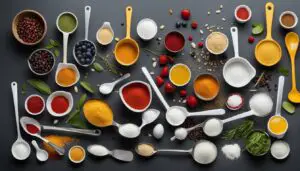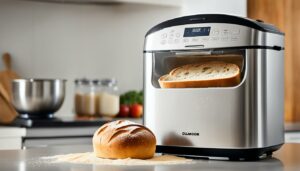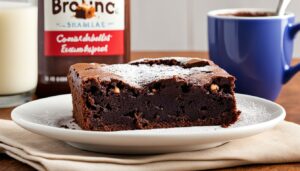Originally posted on March 26, 2024 @ 7:40 pm
When it comes to baking bread, we often follow tried-and-true recipes that call for water as the main liquid ingredient. But have you ever wondered if you can substitute milk for water in a bread recipe? Does it really make a difference in the final result? Let’s explore the impact of using milk instead of water in bread recipes and uncover the benefits it brings to your homemade loaves.
Contents
- 1 Benefits of Using Milk in Bread Recipes
- 2 Types of Milk for Bread Making
- 3 Substituting Milk Powder for Fresh Milk
- 4 Other Substitutions and Variations
- 5 Making Homemade Bread by Hand or in a Bread Machine
- 6 Glass vs. Metal Bread Pans
- 7 Conclusion
- 8 Additional Bread Recipes
- 9 Recommended Equipment and Resources
- 10 FAQ
- 10.1 Can milk be substituted for water in a bread recipe?
- 10.2 What are the benefits of using milk in bread recipes?
- 10.3 What types of milk can be used in bread making?
- 10.4 Can milk powder be substituted for fresh milk in bread recipes?
- 10.5 Are there other substitutions and variations that can be made in bread recipes?
- 10.6 Can bread be made by hand or with a bread machine?
- 10.7 What is the difference between baking bread in a glass pan and a metal pan?
- 10.8 What are some additional bread recipes that incorporate milk?
- 10.9 What equipment and resources are recommended for bread making?
- 10.10 What are the conclusions on using milk instead of water in a bread recipe?
- 11 Source Links
Key Takeaways:
- Milk adds richness, flavor, and tenderness to bread.
- Milk enhances the nutritional value of bread, providing protein, calcium, and vitamins.
- Experimenting with different types of milk can yield varied results in texture and rise.
- Milk powder can be used as a convenient substitute for fresh milk in bread recipes.
- There are various other substitutions, variations, and equipment options for bread making.
Benefits of Using Milk in Bread Recipes
When it comes to making bread, using milk instead of water can elevate the taste, texture, and nutritional value of your loaves. Let’s take a closer look at the benefits of incorporating milk into your bread recipes.
1. Enhanced Nutritional Content
By substituting water with milk, you’re introducing additional nutrients to your bread. Milk is a rich source of protein, calcium, and vitamin B12, which are essential for a healthy diet. So not only will your bread taste delicious, but it will also provide added nutritional value.
2. Improved Texture
Milk contains fat and lactose, which contribute to a tender and delicate crumb in bread. This means that your loaves will be softer and more enjoyable to bite into. The result is a bread that is light, fluffy, and simply irresistible.
3. Sweeter Flavor and Caramelized Crust
The natural sugars present in milk lend a subtle sweetness to your bread. When baked, these sugars also contribute to a beautiful caramelization on the crust, adding depth and complexity to the overall flavor profile. So if you’re looking to create a bread with a touch of sweetness, milk is the way to go.
Incorporating milk into your bread recipes offers a range of benefits, from improved nutrition to enhanced texture and flavor. So why settle for ordinary bread when you can make something extraordinary with milk?
| Benefits of Using Milk in Bread Recipes | Keywords |
|---|---|
| Enhanced Nutritional Content | benefits of using milk in bread recipes |
| Improved Texture | benefits of using milk in bread recipes |
| Sweeter Flavor and Caramelized Crust | benefits of using milk in bread recipes |
Types of Milk for Bread Making
When it comes to making bread, the type of milk you choose can have a significant impact on the final result. Different types of milk offer unique flavors, textures, and nutritional profiles. Here are some of the commonly used milk options for bread making:
- Cow’s Milk: Cow’s milk is the most common type used in bread recipes. It is available in different fat percentages, including whole milk and 2% milk. Whole milk provides a rich and creamy flavor, while 2% milk offers a lighter option.
- Buffalo Milk: For those looking for a richer and fattier taste, buffalo milk can be used in bread making. It has a higher fat content compared to cow’s milk, resulting in a more indulgent loaf.
- Goat’s Milk: Goat’s milk is another alternative that can be used in bread recipes. It has a distinct flavor that may not appeal to everyone, but it adds a unique twist to the bread’s taste.
- Plant-Based Milk: If you prefer a dairy-free option, you can use plant-based milk such as almond milk. However, keep in mind that using plant-based milk may result in slight changes to the taste and texture of the bread.
Experimenting with different types of milk can add variety to your bread recipes and allow you to find the perfect flavor profile that suits your preferences. Whether you opt for cow’s milk, buffalo milk, goat’s milk, or plant-based milk, each option brings its own unique characteristics to the table.
Choose the milk that best suits your taste and dietary preferences to create delicious homemade bread!
Substituting Milk Powder for Fresh Milk
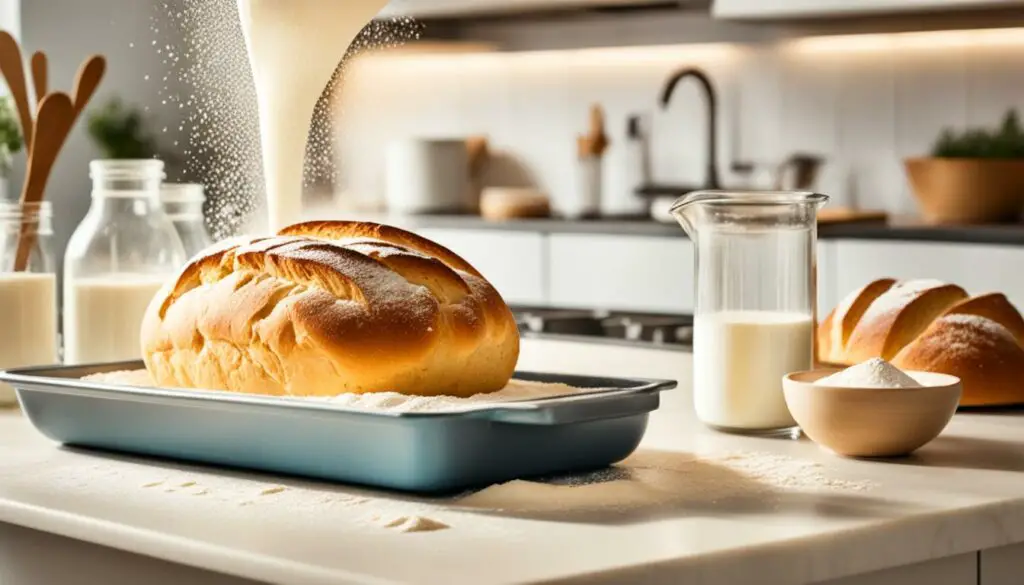
In some cases, bakers opt to use milk powder instead of fresh milk in bread recipes. Milk powder is convenient as it has a longer shelf life and can be easily stored. When using milk powder, it should be mixed with water according to the recommended ratio, usually 1:10. This means that for every gram of milk powder, 10 grams of water should be added. The resulting mixture can be used as a substitute for fresh milk in bread recipes without the need for additional adjustments in hydration.
Using milk powder as a substitute for fresh milk in bread making offers several advantages. It provides the same richness and nutritional value as fresh milk while offering the convenience of extended storage. By simply reconstituting the milk powder with water, bakers can achieve the desired moisture content in their bread dough without compromising the recipe’s balance.
Using milk powder in bread making not only extends the shelf life of the milk but also simplifies the preparation process.
The versatility of milk powder makes it a valuable ingredient in bread recipes, especially in situations where fresh milk may not be readily available or spoilage is a concern. Additionally, using milk powder allows bakers to experiment with different flavors and textures, as the ratio of milk powder to water can be adjusted to achieve desired results.
When substituting milk powder for fresh milk, it is important to follow the recommended ratio and thoroughly mix the powder with water to ensure smooth incorporation into the dough. This helps maintain the moisture and consistency of the bread, resulting in a delicious and wholesome final product.
Other Substitutions and Variations
In addition to substituting milk for water, there are numerous other variations and substitutions that can be made in bread recipes. These alternatives offer the opportunity to customize and experiment with different flavors and textures.
Butter vs. Oil: One simple substitution to consider is using butter instead of oil in bread recipes. Butter adds richness and depth to the flavor of the bread, giving it a buttery aroma and a slightly crisp texture. It can be used in equal amounts to replace oil, but keep in mind that it may affect the final texture of the bread.
Honey vs. Sugar: Another variation to explore is the use of honey instead of sugar as a sweetener in bread recipes. While honey and sugar can be used interchangeably, honey adds a hint of floral sweetness, enhancing the overall taste of the bread. It also helps to retain moisture, resulting in a softer and moister loaf. Experiment with different types of honey to discover unique flavor profiles.
Flour Variations: Playing with different types of flour can also bring diversity to your bread recipes. For a denser and heartier loaf, try using whole wheat flour or a combination of wheat and white flour. Whole wheat flour adds more fiber and nutrients to the bread. Alternatively, using different grains and seeds, such as rye flour or flax seeds, can introduce new flavors and textures.
These substitutions and variations provide opportunities for creativity and innovation in bread making. Don’t be afraid to experiment and discover new flavors and combinations that suit your taste preferences.
Making Homemade Bread by Hand or in a Bread Machine
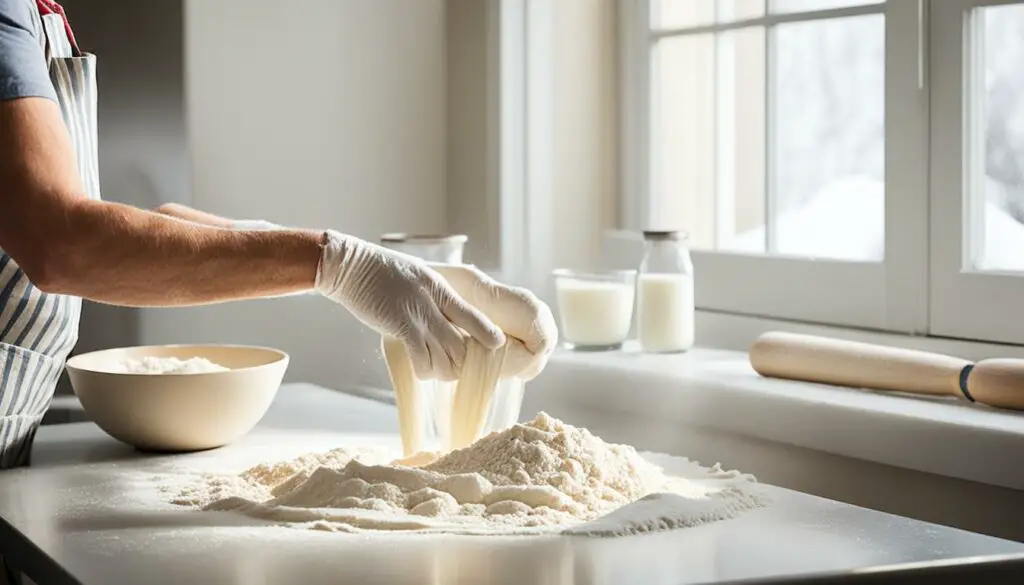
Making bread can be a fulfilling and rewarding experience, whether you choose to do it by hand or with the help of a bread machine. Both methods have their own advantages and offer unique experiences in the bread-making process.
Making bread by hand allows you to have complete control over every aspect of the dough. It requires some physical effort, but it can be a therapeutic and gratifying activity. Kneading the dough by hand allows you to feel the texture and consistency, ensuring that it is properly mixed. Following the recipe’s instructions, you’ll knead the dough until it forms a smooth, elastic ball.
“There is something incredibly satisfying about kneading a dough by hand. It allows you to connect with the bread on a deeper level, and you can appreciate the transformation from a sticky mess to a beautifully elastic dough.” -Jennifer, Home Baker
On the other hand, using a bread machine can save you time and effort. It simplifies the bread-making process by automating most of the steps. All you need to do is add the ingredients, select the appropriate settings based on the recipe, and let the machine do the work. The bread machine takes care of mixing, kneading, and proofing the dough, allowing you to focus on other tasks.
Baking bread with a bread machine can be especially convenient for those with busy lifestyles or limited baking experience. It ensures consistent results and takes the guesswork out of the process. However, it’s essential to follow the machine’s instructions and understand its capabilities to achieve the best results.
Whether you choose to make bread by hand or with a bread machine, the recipe can be adapted accordingly. Recipes that call for water can easily be modified to include milk instead. Simply substitute an equal amount of milk for the water in the recipe and proceed with the rest of the instructions.
Making Homemade Bread by Hand Steps:
- Measure and gather all the necessary ingredients.
- Mix the dry ingredients together in a large bowl.
- Warm the milk to room temperature or slightly above.
- Add the milk to the dry ingredients and mix until a rough dough forms.
- Transfer the dough onto a clean, floured surface and knead for about 10-15 minutes, or until it becomes smooth and elastic.
- Shape the dough into a ball and place it in a lightly greased bowl, covering it with a damp cloth or plastic wrap.
- Allow the dough to rise in a warm place until it doubles in size, usually about 1-2 hours depending on the recipe.
- Punch down the risen dough to remove any air bubbles.
- Shape the dough into the desired form, such as a loaf, rolls, or a braided shape.
- Place the shaped dough into a greased bread pan or on a baking sheet, cover it, and let it rise again until it increases in size, usually for about 30-60 minutes.
- Bake the bread in a preheated oven according to the recipe’s instructions until it is golden brown and sounds hollow when tapped on the bottom.
- Remove the bread from the oven and let it cool before slicing and enjoying.
Using a bread machine:
- Ensure that your bread machine is clean and in good working condition.
- Add the ingredients to the bread machine pan according to the recipe, following the suggested order provided by the manufacturer.
- Select the appropriate settings based on the recipe’s instructions and your desired crust color.
- Start the bread machine and let it do its magic. Avoid opening the lid during the baking process to prevent heat loss.
- Once the bread is done, carefully remove it from the bread machine and let it cool on a wire rack before slicing.
Regardless of the method you choose, making homemade bread is a satisfying experience that results in a delicious loaf. The choice between making it by hand or using a bread machine depends on personal preference, time constraints, and desired level of involvement in the bread-making process.
Glass vs. Metal Bread Pans
The choice between using a glass or metal bread pan can impact the final result of the bread. Baking bread in a glass pan tends to produce a softer crust and lighter browning. On the other hand, baking bread in a metal pan, especially a darker one, results in a crispier crust with a darker brown color.
Both options can yield delicious loaves, but the choice depends on personal preference for crust texture and appearance.
Conclusion
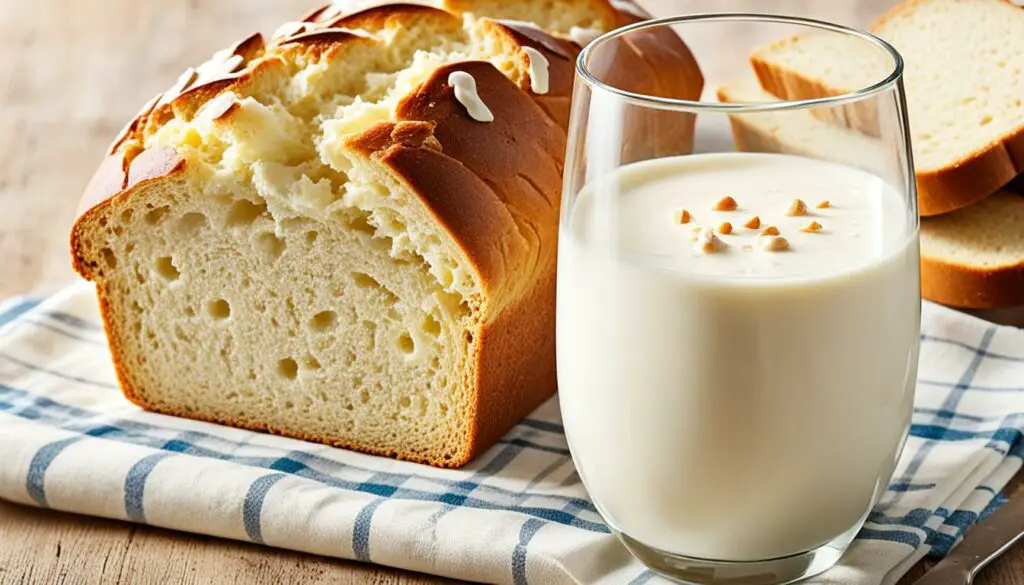
After exploring the benefits of using milk instead of water in bread recipes, it is clear that this substitution offers numerous advantages. By incorporating milk into your bread recipe, you can achieve a richer flavor, improved texture, and enhanced nutritional value. The use of milk adds a touch of sweetness and tenderness to the crumb, resulting in a softer and more enjoyable loaf of bread.
Whether you choose to use whole milk, plant-based milk, or other variations, such as buffalo milk or goat’s milk, there are endless possibilities for customization and experimentation. You can also try substituting milk powder for fresh milk, following the recommended ratio to simplify the process without compromising the quality of the bread.
Regardless of whether you prefer making bread by hand or with the help of a bread machine, the recipe can be adapted accordingly. The decision to use milk in bread recipes ultimately comes down to personal preference and desired outcomes. Whether you’re looking for a more flavorful loaf, a softer crumb, or added nutritional benefits, incorporating milk into your bread recipe can be a game-changer.
So why not give it a try? Experiment with different types of milk, explore variations in sweeteners like honey or sugar, and discover the perfect blend of flavors and textures that suit your taste buds. With milk as a key ingredient, you can take your homemade bread to a whole new level, delighting friends and family with every slice.
Additional Bread Recipes
Looking for more bread recipes? Here are a few recommendations to take your bread-baking adventures further:
- Classic French Baguette
- Cheddar and Jalapeno Bread
- Cinnamon Swirl Bread
- Garlic and Herb Focaccia
- Honey Whole Wheat Bread
- Brioche Burger Buns
| Bread Recipe | Description |
|---|---|
| Classic French Baguette | A traditional French bread with a crisp crust and airy crumb, perfect for sandwiches or dipping in olive oil. |
| Cheddar and Jalapeno Bread | A savory bread loaded with sharp cheddar cheese and spicy jalapenos, ideal for serving as a side or appetizer. |
| Cinnamon Swirl Bread | A sweet and comforting bread swirled with cinnamon and sugar, great for toasting or making French toast. |
| Garlic and Herb Focaccia | An aromatic and flavorful Italian bread topped with garlic, herbs, and a drizzle of olive oil. |
| Honey Whole Wheat Bread | A wholesome and slightly sweet bread made with whole wheat flour and a touch of honey. |
| Brioche Burger Buns | Soft and buttery buns perfect for hamburgers, sliders, or pulled pork sandwiches. |
Additional Bread Recipes
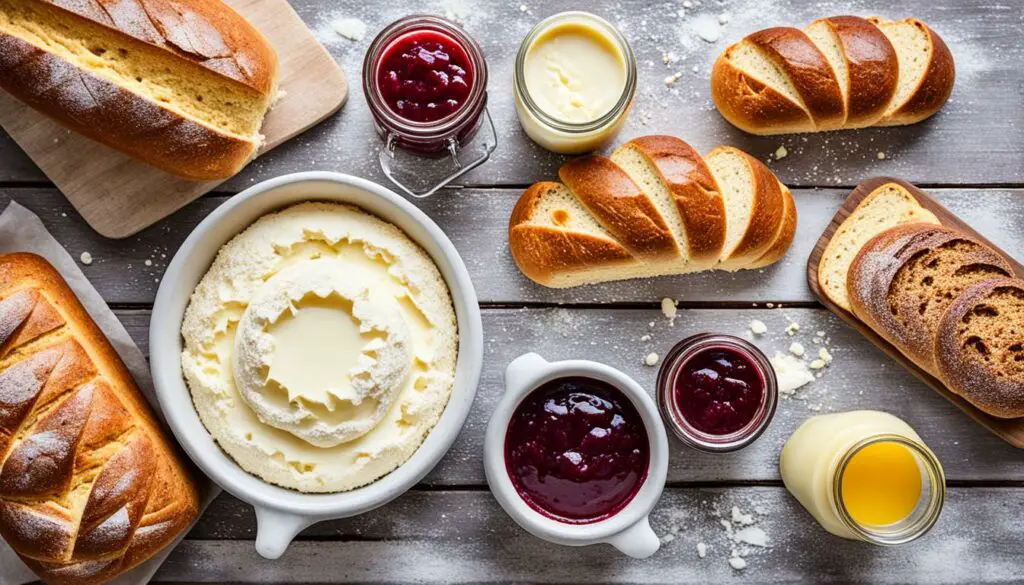
Looking to expand your bread recipe collection? Here are some delicious options that incorporate the richness of milk. Whether you prefer classic loaves or sweet treats, these recipes offer a variety of flavors and textures to satisfy your cravings.
1. Traditional White Bread
A staple in many households, traditional white bread is a versatile and timeless recipe. The addition of milk gives it a softer and more tender crumb, making it perfect for sandwiches or toast.
2. Cinnamon Rolls
Sweet and gooey cinnamon rolls are a favorite indulgence. By substituting water with milk, the dough becomes richer and the rolls turn out even more decadent. Don’t forget the cream cheese frosting for that extra touch of sweetness!
3. Burger Buns
Want to elevate your backyard barbecue? Homemade burger buns made with milk take your burgers to a whole new level. They have a soft texture and a subtle hint of sweetness that perfectly complements the savory patty.
4. Savory Monkey Bread
A savory twist on the classic monkey bread, this recipe combines milk with herbs, cheese, and garlic for a flavorful and irresistible treat. It’s perfect for sharing at parties or enjoying as a snack.
5. Banana Bread
Got overripe bananas? Turn them into a moist and delicious banana bread with the help of milk. The added moisture from the milk prevents the bread from drying out, resulting in a perfect afternoon treat.
| Bread Recipe | Key Ingredients |
|---|---|
| Traditional White Bread | Flour, yeast, milk, sugar, salt |
| Cinnamon Rolls | Flour, yeast, milk, butter, sugar, cinnamon |
| Burger Buns | Flour, yeast, milk, butter, sugar, salt |
| Savory Monkey Bread | Flour, yeast, milk, butter, garlic, cheese, herbs |
| Banana Bread | Flour, bananas, milk, sugar, butter, eggs |
These recipes are just a starting point. Feel free to experiment with different variations by adding ingredients like nuts, dried fruits, or chocolate chips to personalize your bread creations. Let your imagination run wild and enjoy the delightful results!
Recommended Equipment and Resources
To create the best homemade bread, it’s essential to have the right equipment and resources. One valuable tool for bread making is a bread machine. A bread machine simplifies the entire process, from mixing the dough to baking the perfect loaf, ensuring consistent and delicious results every time.
In addition to a bread machine, there are a few other essential items that you should have in your bread-making arsenal. A good bread knife is essential for slicing your freshly baked bread with precision. Look for a knife with a sharp serrated blade, which will help you achieve clean and even slices. And of course, a set of reliable measuring cups is crucial for accurate measurements, ensuring that your bread turns out just right.
While having the right equipment is important, it’s also helpful to have access to additional resources to enhance your bread-making skills and knowledge. Instructional videos and online guides can provide valuable insights and tips from expert bakers. They can help you refine your techniques, learn new recipes, and troubleshoot any issues that may arise during the bread-making process.
Investing in recommended equipment and leveraging additional resources will empower you to create delicious homemade bread that you can be proud of. So, gather your bread machine, bread knife, measuring cups, and explore the wealth of knowledge available online. Get ready to embark on an exciting, flavorful, and rewarding bread-making journey!
FAQ
Can milk be substituted for water in a bread recipe?
Yes, milk can be substituted for water in a bread recipe. Using milk instead of water adds richness, improves texture, and makes the bread softer and fluffier. It also adds nutrition and a touch of sweetness to the loaf.
What are the benefits of using milk in bread recipes?
Using milk in bread recipes enhances the taste, texture, and nutritional value of the final loaf. Milk adds protein, calcium, and vitamin B12 to the bread. It also tenderizes the crumb, making it softer, and contributes to a sweeter flavor and a more caramelized crust when baked.
What types of milk can be used in bread making?
The most common types of milk used in bread making are cow’s milk, such as whole milk or 2% milk. Buffalo milk can also be used for a richer taste, and goat’s milk is an alternative with a distinct flavor. Plant-based milk, like almond milk, can be used as a dairy-free option, but it may alter the flavor and texture of the bread.
Can milk powder be substituted for fresh milk in bread recipes?
Yes, milk powder can be substituted for fresh milk in bread recipes. To use milk powder, it should be mixed with water according to the recommended ratio, usually 1:10. This resulting mixture can be used as a substitute for fresh milk without the need for additional adjustments in hydration.
Are there other substitutions and variations that can be made in bread recipes?
Yes, there are several other substitutions and variations that can be made in bread recipes. For example, butter can be used instead of oil, and honey can be used interchangeably with sugar as a sweetener. Different types of flour, such as wheat flour or a combination of wheat and white flour, can also be used.
Can bread be made by hand or with a bread machine?
Yes, bread can be made both by hand and with a bread machine. Kneading the dough by hand allows for more control and a hands-on experience, while using a bread machine automates most of the steps and simplifies the process. The recipe can be adapted accordingly for each method.
What is the difference between baking bread in a glass pan and a metal pan?
Baking bread in a glass pan tends to produce a softer crust and lighter browning, while baking it in a metal pan, especially a darker one, results in a crispier crust with a darker brown color. The choice depends on personal preference for crust texture and appearance.
What are some additional bread recipes that incorporate milk?
There are countless bread recipes available that incorporate milk, ranging from traditional white bread to sweet rolls and burger buns. Experimenting with different variations, such as adding butter, eggs, or sugar, can further enhance the flavor and texture of the bread.
What equipment and resources are recommended for bread making?
To create the best homemade bread, it is recommended to have a bread machine for simplified and consistent results. Additionally, owning a good bread knife and measuring cups can aid in accurate measurements and slicing the bread. Additional resources, like instructional videos or online guides, can also be helpful for enhancing bread-making skills and knowledge.
What are the conclusions on using milk instead of water in a bread recipe?
Using milk instead of water in a bread recipe offers numerous benefits, including improved flavor, texture, and nutrition. Milk adds richness and tenderness to the crumb, making it softer and more enjoyable. The choice of milk, such as whole milk or plant-based milk, allows for further customization and experimentation.


